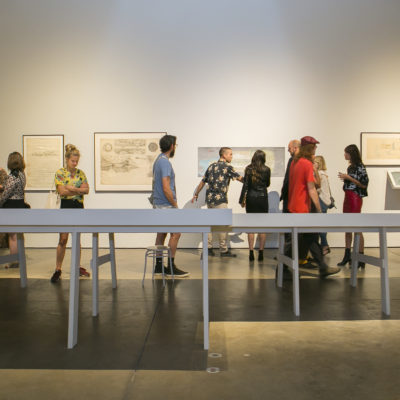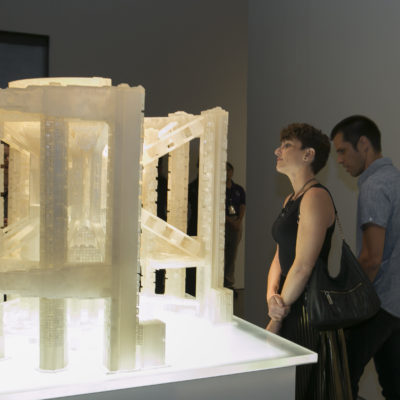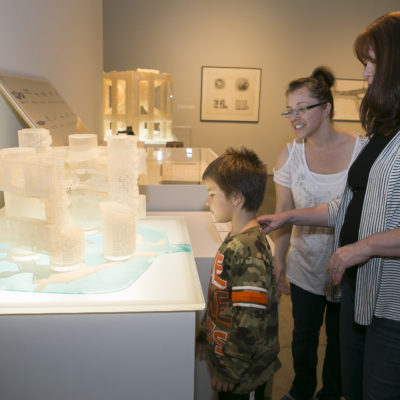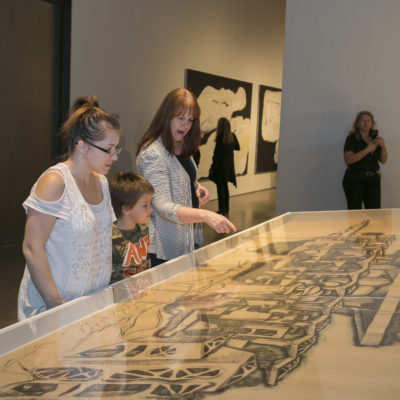I met Claire Carter in 2015 at Arcosanti, in the cafe, while having lunch with Jeff Stein. She told me about an exhibit she was curating about Soleri — which was going up in what seemed like the way, way, WAY distant future. I put forth the idea of doing an interview for the blog, and she agreed to do it when the exhibit opened. Lo! It has opened! You can see Repositioning Paolo Soleri: The City is Nature at the Scottsdale Museum of Contemporary Art (SMoCA) from now until January 28, 2018.
How did you come to be a curator, and specifically, work with Soleri artifacts?
In the 1980s, the city of Scottsdale commissioned a bridge design from Soleri. Due to political roadblocks, it was delayed until 2011. When the project was revitalized in the 2000s, Scottsdale Public Art, a sister institution to the Scottsdale Museum of Contemporary Art where I am a curator, managed the construction of the bridge and installation of original artwork by Soleri. In the spirit of collaboration, the museum decided to present an exhibition of Soleri’s bridge designs. I was assigned by our (now former) director Timothy Rodgers to steward the project. Working in the archives was a revelation and both Dr. Rodgers and I proposed a three-exhibition series to the Foundation.

This isn’t the only Soleri exhibit you curated, is that right?
In 2013 SMoCA presented the exhibition Paolo Soleri: Mesa City to Arcosanti. The show focused on Soleri’s three largest conceptual cities—Mesa City, Macro-Cosanti and Arcosanti. It was structured around two large scrolls and an early model of Arcosanti made of acrylic. It also provided photographic documentation of the Silt Pile and Arcosanti workshops, as well as construction of Arcosanti from 1969 – today.
What can we expect to see in Repositioning Paolo Soleri: The City is Nature?
I conceptualized this final exhibition in the series as a retrospective of Soleri’s work. I thought it was important to survey the variety of mediums Soleri explored: drawing, sculpture, carving, painting, ceramics, bronze and aluminum casting, earth cast concrete construction and silt cast slab construction, among others. I wanted to include his craft production as equal to his artwork, as he exhibited all media in international exhibitions. Another overlooked facet of Soleri’s history is how respected he was by his peers and contemporaries. In addition to rare drafts and first edition catalogues, the exhibition also presents a variety of ephemera, posters, fundraising materials, and media coverage including Harpers, Newsweek, New York Times Magazine, Rolling Stone and Vogue. I also wanted to reflect upon how public perception of Soleri began to shift in the mid-1970s after construction on Arcosanti was underway.
And now some photos from Repositioning Paolo Soleri: The City is Nature at SMoCA. Photos by Chris Loomis.
Soleri was so prolific, how do you decide what to exhibit and what not to exhibit?
Truthfully, it is a really tough process. I have been studying Soleri’s artwork and archives for 8 years and I still question whether I made the right choices. The main problem for curators (usually) is the editing process. I would have happily made the exhibition twice as large. However, the key to a compelling exhibition is culling the extraneous and selecting only the objects that make unique arguments. The exhibition catalogue (essay, footnotes, annotated bibliography) is the place to provide the reader greater access to my research and provide a deeper analysis than is possible in gallery texts.
What are, for you, the stand out pieces of this show? Why?
I am very proud that we have on loan from the Museum of Modern Art, New York a model of Dome House Soleri constructed in 1951. It has never been exhibited in Arizona, despite the fact that Dome House was built here in the Phoenix valley and is still inhabited. My favorite scroll in the exhibition is from 1960 called History of Man .
From Soleri’s craft practice, we have almost twenty examples of very early ceramic bells on loan from private collectors. Last, I am very proud to display three bridge models misplaced in 1971 that we rediscovered during my research. The museum has since stored and conserved the models and after the exhibition they will return home to the foundation archives at Arcosanti.
Is there anything you’d like to have but can’t get your hands on?
Oh yes, so many things. I would love to have examples of the ceramic vases, lampshades and table legs Soleri made in the 1960s. There is a spectacular bronze lantern almost 20 inches high that appears in a photograph of Cosanti taken by Charles Eames dating from the early 1960s. I found it listed in an exhibition catalogue the Museum of Contemporary Craft in New York titled Light Vase and documented in the American Craft Council archives. However, none of the publications include the owner, so I was unable to track it down. I also would have loved to present the massive cardboard model 3-D Jersey, a design for an integrated city/airport Soleri proposed in 1968. Unfortunately the model was destroyed sometime after the 1969 Corcoran exhibition, The Architectural Vision of Paolo Soleri.
Are there more Soleri shows to be put on?
Absolutely! Soleri worked prolifically for over 60 years—drawing, sculpting, drafting and writing. There is a wealth of material to exhume that I wasn’t able to include in our project. As for SMoCA, I doubt the museum will present another solo exhibition of Soleri. He is the only artist to whom we have devoted a multi-part exhibition series and I believe we feel like we successfully presented new research as well as helped conserve and preserve artworks key to Arizona’s artistic patrimony.
Thanks, Claire!
Claire C. Carter is Curator of Contemporary Art at the Scottsdale Museum of Contemporary Art where she has curated visual art, architecture and design since 2007. Among her recent original exhibitions are Sama Alshaibi: Silsila (currently on view at the Herbert F. Johnson Museum at Cornell University); Covert Operations: Investigating the Known Unknowns; and The Five Senses: Janet Cardiff, Olafur Eliasson, Spencer Finch, Roelof Louw, Ernesto Neto. Her projects have been supported by the Emily Hall Tremaine Foundation, Graham Foundation for Advanced Studies in the Fine Arts and the National Endowment for the Arts, among others. She is an author of three internationally distributed books and has received awards from the American Alliance of Museums, the American Institute for Graphic Arts and the Association of Art Museum Curators. Her latest exhibition, Repositioning Paolo Soleri: The City is Nature, runs from October 14, 2017 to January 28, 2018.







Louis Dallara
Great Blog
David Licata
Thanks, Louis!!!